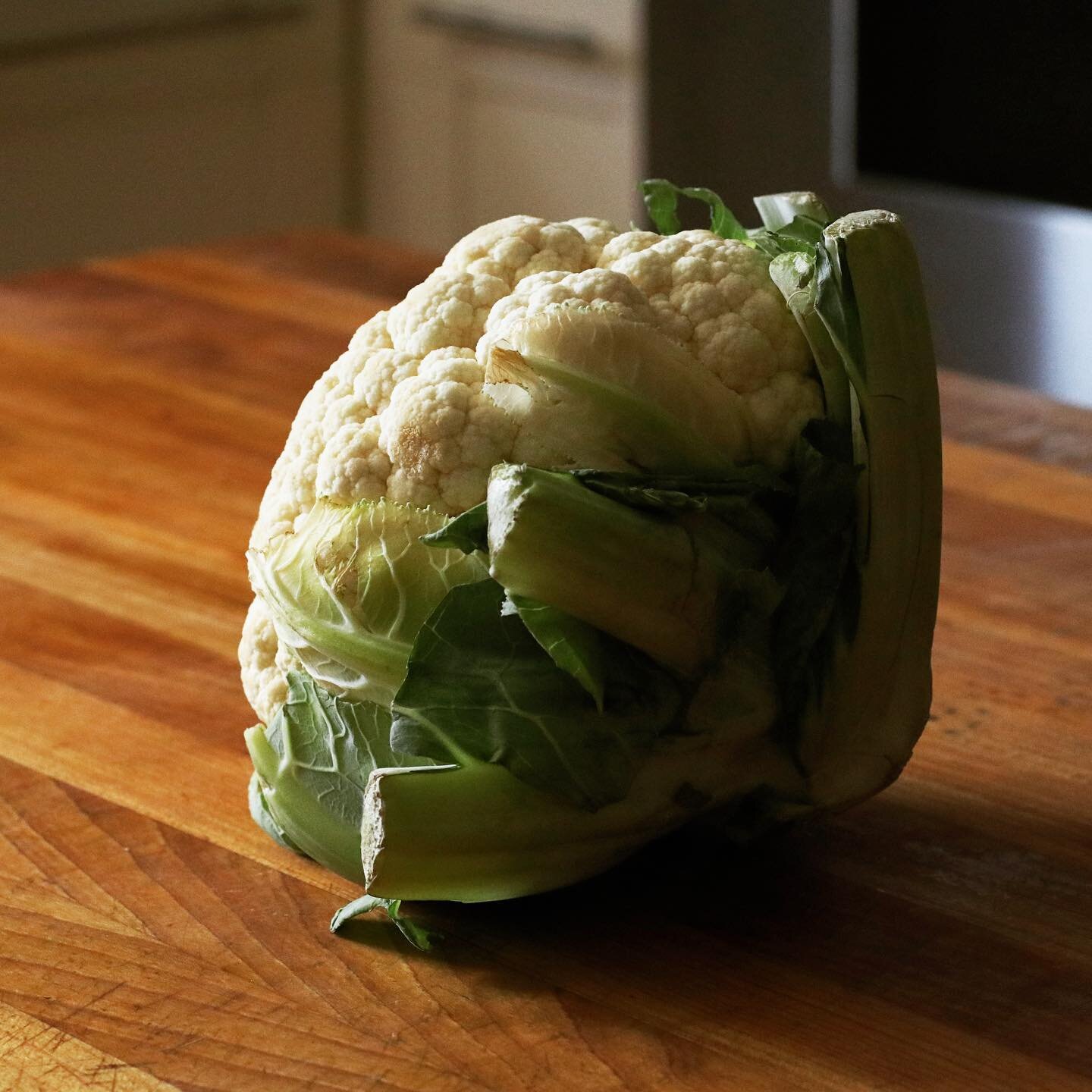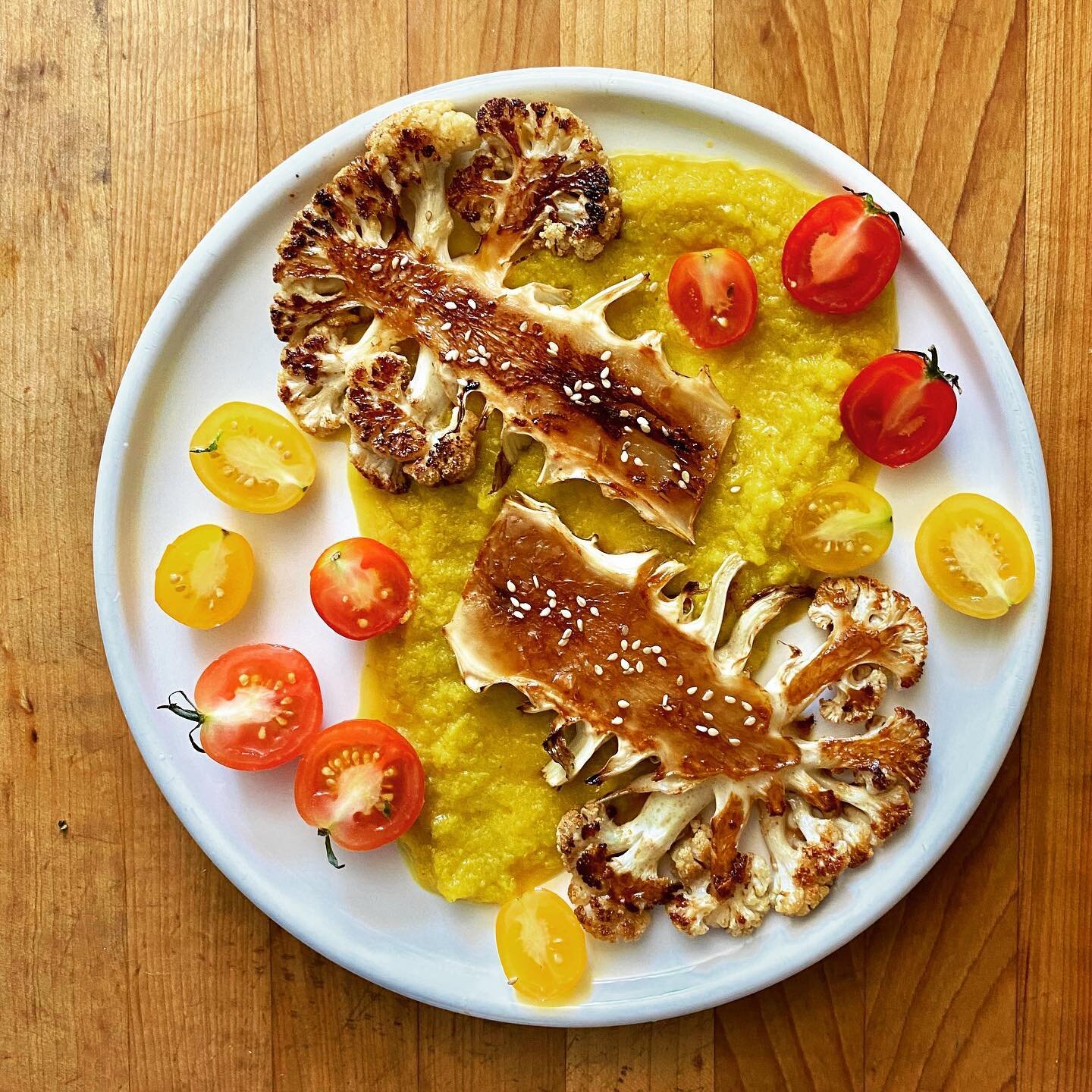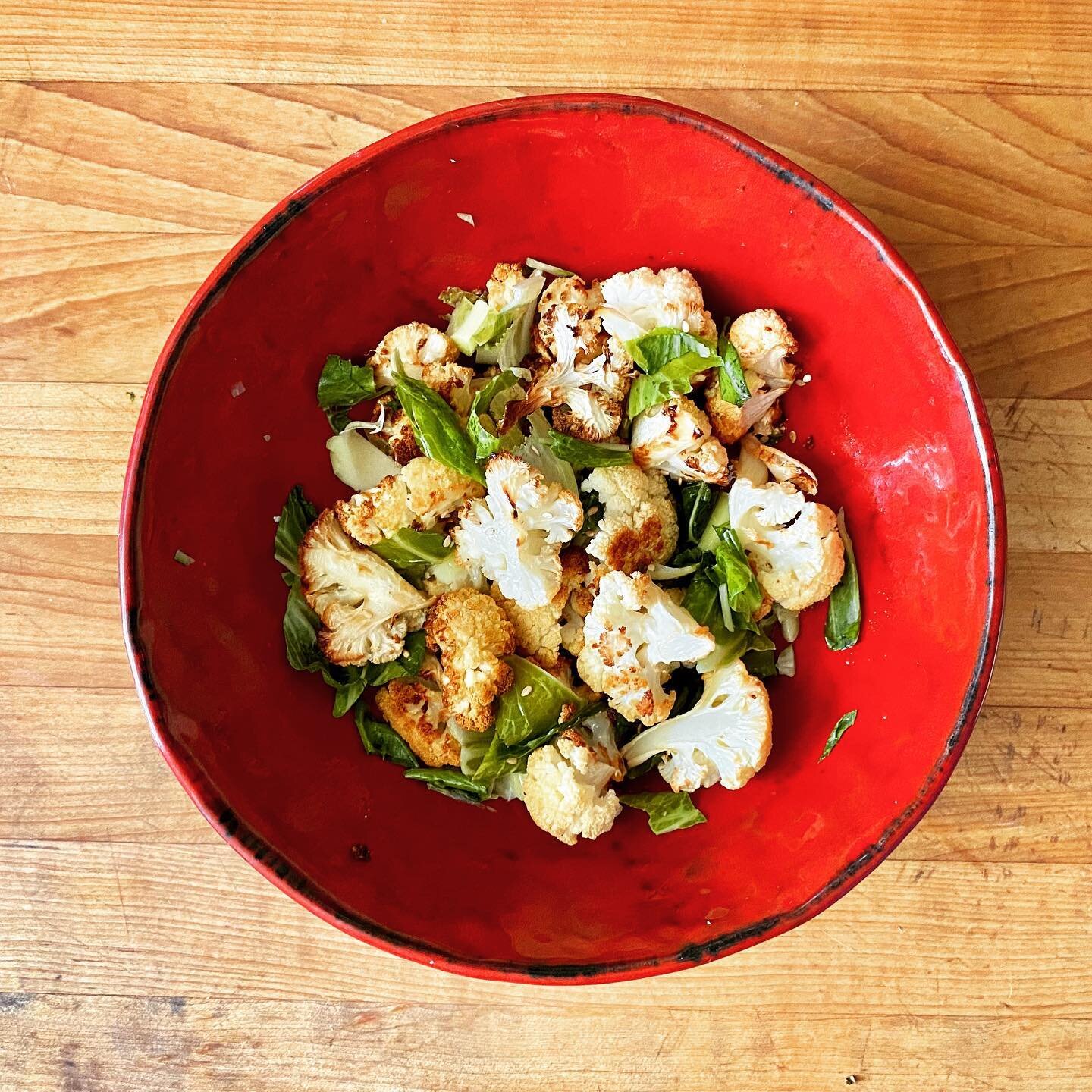WiN-WiN: Cauliflower Steaks with a Cold Sesame Salad
This is our first installment of the WiN-WiN recipe series (Waste Not, Want Not). In this series, we try to make use of every last bit of a vegetable, fruit, legume, etc. Doing this not only respects all of the time and energy that went into producing that beautiful food, but offers you a ton of extra use, a new world of flavors and textures, and a door to a new realm of creativity and experimentation.
With this recipe, we set out to conquer a challenge: could you use every single piece of a whole head of cauliflower in one recipe? Most of us are accustomed to eating just one part of the cauliflower: the florets. The florets are the “flowers” of the cauliflower, the bumpy-bits that stick out from small and tender stems. What often gets left behind are the larger stems that connect to the core, as well as the thick leaves that sprout from the very bottom of it all. Why let these go to waste? Not only are they incredibly delicious if cooked with care, they also display the diversity of flavors and textures and uses that all coexist within one beautiful piece of produce!
Our recipe takes one approach to this challenge, but we encourage you to explore other options and experiment! Unless you burn something to an absolute crisp, it’s hard to mess up tooooo badly. There’s always a new direction to explore, be brave, be curious, be creative!
This recipe utilizes the “meaty” quality of cauliflower steaks (thick cuts of a head of cauliflower that extend from the core to the floret), the rich umami of the core and leaf-stems, and the bright freshness of the florets and leafy-greens. The cauliflower steaks are roasted and then seared with a soy glaze, accompanied by a savory sauce made from stewing and then pureeing the core and stems, and paired with a bright cold sesame salad from roasted-then-chilled florets and greens. Check it out!
Ingredients:
1 whole cauliflower head: if you can get one that still has its leaves wrapped around it, all the better!
1/2 medium onion: diced
3 cloves garlic: sliced
1 ½ tbsp Soy Sauce
1 tbsp Sesame Oil
2 tbsp Rice Wine
1 tbsp rice vinegar
1 ½ tbsp sesame seeds
½ cup Cherry tomatoes: halved
Neutral Oil: like avocado, canola, etc.
Preparation:
Break down your cauliflower:
Gently cut away the leaves from the stem-core, as low as possible.
Then gently cut along the length of the cauliflower (from the bottom of the stem through the top) to remove the excess florets. Then separate the core into 3 steaks (these should be ½-¾ inches thick.
Then break the excess florets up into roughly 1-1 ½ inch pieces
Save any small pieces of cauliflower that have crumbled off during your cuts!
Then separate the greens from the leaf stems. Slice the leaf stems into roughly ¼ inch slices. Slice the greens into roughly ½ slices.
Preheat an oven to 350 degrees, spread your steaks and florets out evenly on a parchment lined baking tray, drizzle and spread roughly 2 tbsp of neutral oil until everything is coated. Cook until the thickest part of the steak’s core can be easily pierced with a fork.
Meanwhile, add your onions, garlic, and sliced leaf-stems as well as any little crumbled bits of cauliflower into a large pan on medium heat with roughly 2 tbsp of neutral oil. Sauté, stirring every minute or so. After 10 minutes of sautéing, some brown spots may appear on the bottom of the pan, deglaze by adding in the Rice wine and using a spatula to scrape up all the browned bits. Continue to cook until the onions and leaf stems have become translucent and slightly browned. Then add in ½ of water and stir well. Cook for another 5 minutes, then add in salt to taste, and ½ tbsp of sesame oil. Once the mixture has approached something of a tasty-stew, take it off the heat, and let it cool before adding it to a food processor and blending until totally smooth.
Troubleshoot: if the final mixture is lacking flavor, add salt and rice vinegar in small amounts until the sauce is flavorful. If the final mixture is too thick, add small amounts of water and re-blend until it's at your desired consistency (it should be like thin mashed potatoes), if it's too thin, add it back to the pan on low heat and cook until it thickens.
Once your steaks and florist are done roasting, remove the florets and place them in a bowl and then in the refrigerator to cool. In the meantime, get a pan large enough to comfortably fit one steak, place it on medium-high heat with enough neutral oil to coat the bottom and ½ tsp of soy sauce. Once the oil begins to shimmer, gently add your steak in and sear until a dark brown crust begins to form, flip and sear the other side. Repeat with all of your steaks (adding soy sauce as necessary).
Once the florets have chilled, toss them in a large bowl with your sliced greens, ½ tbsp sesame oil, 1 tbsp rice vinegar, a pinch of salt, and 1 tbsp of sesame seeds.
Plate your steaks: place a big spoonful of your sauce on the plate and in one sweeping motion, spread it along the length of the plate. Place your steaks along the streak of sauce, place your halved tomatoes around them, and top with a sprinkle of sesame seeds. Enjoy!
Best Practices:
As always:
Avoid packaged produce, or really anything packaged for that matter. This is not to say that you’ll always have the option, but when you do, go for it! For example, you may sometimes see garlic in nylon netting, or onions and cauliflower in plastic bags. These are all very often available sans any container, so take the opportunity to use your hands, smell the produce, build that relationship with your ingredients! Pick your battles and fight them well!
Try to bring your own bags when you go shopping for these ingredients
Make sure you’re not buying more than you think you’ll reasonably use! Things like garlic and onions will all last a while, so with those if you buy a bit more than you needed, you’ll have plenty of time to use them in the future. But with the cauliflower, it will go bad fairly quickly so buy with care!
These ingredients have been chosen with several things in mind:
Most of these ingredients are household staples that are relatively inexpensive and last a long time. Cauliflower is grown all around the US and is often in season. It also stores well in your fridge for a long time if you wrap it up tight.
As previously mentioned, this recipe aims to reduce waste and highlight new flavors! Make sure you try to reduce waste whenever you can. For example, the skins and butts of the garlic and onions can be reused for stock and/or compost.
Some of the flavoring ingredients used, such as the Soy Sauce, Rice Wine, Rice Vinegar, Sesame Oil, and Sesame Seeds, are incredibly versatile ingredients that can easily be used to elevate any number of dishes you cook at home, and can last an incredible long time. We highly recommend you add these to your pantry if you can!
Did you like this recipe? Let us know! If you really loved it, share it on social media and tag us (@groundedgrub), or, better yet, share it with your friends and family!






